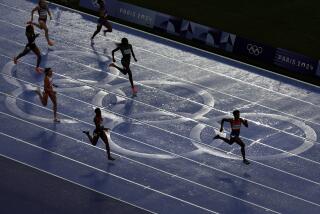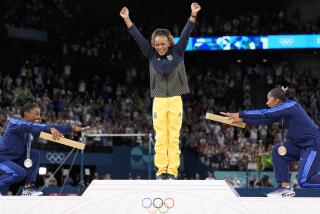The real women of the Games
- Share via
Gee, someone deserves a medal! Women of a certain heft are suddenly everywhere.
“Mad Men’s” Christina Hendricks, the Jessica Rabbit-proportioned redhead who also happens to be a good actress, is on the cover of New York Magazine. Michelle Obama, who a recent Times editorial described as an “athletic, real-woman-with-curves,” launched her initiative to fight childhood obesity. Meanwhile, the Winter Olympics is the source of some interesting insights into what athletes -- especially female athletes -- actually weigh.
Sure, the figure skaters are mostly sparrow-like. But a lot of ladies in other sports are, well, substantial. Elana Meyers of the U.S. women’s bobsledding team is, according to the Team USA website, 5 foot 8 and 180 pounds (stats that are pretty much in line with those of her teammates). The U.S. women’s hockey team captain, Natalie Darwitz, is 5 foot 2 and 143 pounds. Alpine skier and gold medalist Lindsey Vonn, who appears in a bikini in Sports Illustrated’s swimsuit issue, is 5 foot 10 and weighs in at 165 pounds.
Of course, there’s nothing surprising about a muscular athlete weighing more than a bony fashion model or even a flabby-if-thin regular person. But unlike in real life (thank goodness), we are watching Olympic athletes’ heights and weights -- in sports like luge or bobsled, where such stats are relevant -- flashed across the screen for all the world to see.
It’s the opposite of watching movies or television shows, which might as well taunt viewers with subtitles like “ Eva Longoria: size 0” or “ Jennifer Aniston: tighter than you’ll ever be.” Instead, the Winter Olympics have added a novel dimension to the nation’s ceaseless obsession with female body weight -- actual numbers.
Moreover, they’re putting not only a human face on those numbers but some pretty glamorous faces. It’s one thing to see perfunctory footage of protruding bellies during TV news reports about the obesity epidemic, or to hear the latest stats from the Centers for Disease Control and Prevention about the average American woman, who stands 5 feet, 4 inches and weighs just over 164 pounds. It’s quite another thing to see a woman in that approximate height-and-weight range competing in the Olympics. The Vancouver Games are providing something those height-and-weight charts cannot: evidence that when it comes to fitness and looks, the numbers are only part of the
equation.
Still, I know what you’re thinking. For most of us, 164 pounds on a 5-foot-4 frame is probably too much. Besides, some of these ladies competing in Vancouver are, you know . . . big. Not fat, of course, but let’s put it this way: I don’t think I was the only one who, looking at the Sports Illustrated photos of Vonn, wondered how much Photoshopping took place.
Not because she isn’t a beautiful woman, but because a photo of anyone who weighs 40 to 50 pounds more than the average fashion model of the same height is likely to get some technological assistance, especially when the woman depicted is wearing a fringe bikini and thigh-high furry boots (and especially when not even professional models are immune to nips and tucks from art directors).
That’s why, for all the lip-service paid to the culture’s growing acceptance of normal-sized women, we’re still a long way from bestowing words like “attractive” -- or even “fit” -- on anyone who’s less than discernibly thin. We put Christina Hendricks on a magazine cover, but then we congratulate ourselves for “accepting” her. We call Michelle Obama, who is known to work with expensive trainers, a “real-woman-with-curves” while ignoring the fact that more accurate examples of that description would probably take the form of Laura Bush or Hillary Rodham Clinton.
But every time the weight of another female athlete makes it into our brains, we move ever so slightly away from lip-service and toward another kind of service, the kind that chips away at the idea that the only women who deserve to be proud of their bodies are those whose weight doesn’t exceed that of your average otterhound.
Instead of congratulating ourselves (in a way), we’re congratulating them. Instead of marveling at their ability to excel despite what they weigh, we’re forced to concede that going down a mountain at breakneck speed, and who knows what else, is not for the faint of heart -- or the size 0.
More to Read
Go beyond the scoreboard
Get the latest on L.A.'s teams in the daily Sports Report newsletter.
You may occasionally receive promotional content from the Los Angeles Times.







